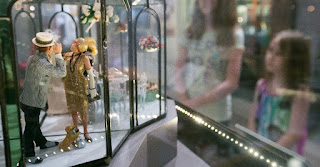If you die, what’s the plan for the next life
If you die, what’s the plan for the next life?” This is the question posed in the opening scene of the recent BBC adaptation of Kate Atkinson’s 2013 novel Life After Life, in which the protagonist, Ursula, repeatedly dies and starts over from birth. It’s a fascinating idea: what would you do differently, and what would remain the same? It is one explored in another hit TV show that has just returned for a second season, Russian Doll, the first season of which saw the main character, Nadia, return endlessly to the night of her 36th birthday party, suffering a different death each time.
Mainstream film and television have a long history of playing with time loops. But while Groundhog Day was a huge success in the early 1990s, narratives about ordinary people caught in this speculative twist have been harder to pull off in literature. Perhaps this is because there tends to be an earnestness to such stories that doesn’t translate into fiction, and a tendency towards repetition that readers may not tolerate as well as viewers. It is trickier to create a montage in fiction: part of what makes Groundhog Day so compelling is the ability to only show the differences in Bill Murray’s repeating days.
There have been some notable time loop successes in contemporary fiction since then, including Atkinson’s Life After Life, and The Seven Deaths of Evelyn Hardcastle by Stuart Turton, in which the protagonist relives the day of a murder in a country house, in a different guest’s body each time. Before I Go to Sleep by SJ Watson also dealt with a loop of sorts: he used amnesia as the device that caused the heroine to reset each day. But now there seems to be a particular appetite for novels that play with time in different ways.
I had the idea for my own time loop novel, Wrong Place Wrong Time, after watching Russian Doll. Mine was a seemingly simple conceit: what if you witnessed your son commit a murder, but then woke up the day before it happened, and then each time a further day before the murder? It made sense to me to travel backwards to try to find the inception of a crime, which is inevitably buried somewhere in history.
My novel takes the Groundhog Day concept and moves it backwards. Meanwhile, Impossible, a recent comic romance by Sarah Lotz, takes the approach of the film Sliding Doors into another dimension. Lotz’s two main characters meet via an email glitch; only when they try to find each other at a train station do they realise they are in different and parallel universes. Her characters are divided through time. In mine, my protagonist moves through it looking for an answer.
There are more of these novels to come, too, and many of them are romcoms. Lindsey Kelk’s forthcoming book, The Christmas Wish, is a Groundhog Day festive thriller in which all of her characters’ Christmas wishes are granted in alternative narratives. Cesca Major’s next novel, Maybe Next Time, is about a literary agent doomed to repeat the day her husband dies until she stops the event from happening. In Emma Straub’s new book, This Time Tomorrow, a woman wakes up in her childhood bedroom, aged 16, and reconnects with her father who, in the present day, is dying.
It’s not difficult to imagine why novelists might want to escape the confines of the present day in their fictional universes – especially in the current political climate. I wonder also whether the pandemic and resulting lockdowns contributed to the sense of time as elastic or illusory; a concept that snapped in March 2020 (how often did you say the phrase, “It’s like Groundhog Day” during the lockdowns?). Fiction usually fulfils the desire to escape, and a time travel book ratchets that up a notch. Do we delve more into the speculative realm the worse life gets?
I think there is an element of nostalgia at play, too. Most time travel movies and novels explore the past, at least briefly – This Time Tomorrow has a deliciously warm nostalgia to it: the heroine’s childhood bedroom, the posters, the fashion – and perhaps, in times of stress, we all look backwards to a place of safety.
Ultimately, though, I think what all of these novels, films and television shows do is reach a hand out – as Alan Bennett said – and hold yours. I found comfort, strangely, in watching the 1918 pandemic unfold in Life After Life, knowing that it would end, and life would begin again.
And I suppose, more than that, creative work about time taps into the human desire to change the past – whether it’s because you can’t remember it, as in Before I Go to Sleep or because you have a true second chance, as in Russian Doll. It’s an irresistible concept to humans. In Wrong Place Wrong Time, my protagonist moves much further back than she first thought, and witnesses significant days in her own life. What would you do if you could relive the day you turned 30? Your wedding day? The birth of your first child? The experience would be totally different because you could anticipate the future. Knowing how things turn out takes the uncertainty and anxiety out of life – paradoxically, even if the outcome is bad. In fiction, a writer can play out these alternative strands, observe the cause and effect of them, and, hopefully, make a bit more sense of the chaotic world we live in.
“If you die, what’s the plan for the next life?” I find this a supremely comforting question. The notion that there could be a plan, or a do over. That nothing is fixed, that no mistake is permanent. Nobody can resist reading about that.
Read Also :


Comments
Post a Comment